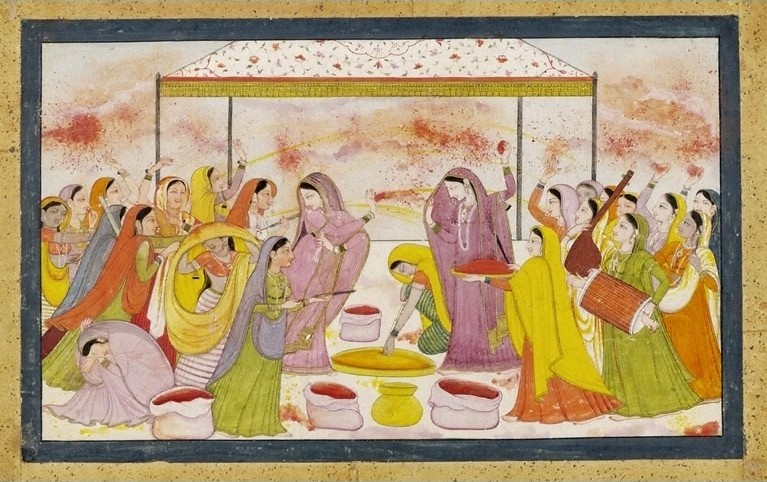The valleys and hills of the Lower Himalayas in Himachal Pradesh, India is beautiful and inspiring. Nature’s beauty echoes here in greenery and cool scenery. The Pahari school of Indian painting flourished here during the 18th and 19th centuries. Of the different schools, the Kangra style is very famous and well known. The erstwhile Kangra princely state is majorly responsible for the development and flowering of the style. Sometimes Pahari school is used synonymously with the Kangra style though there are many variations ! Kangra painting has its This style uses a lot of green and other refreshing colours. The painters used colours from minerals and vegetal sources. The distinctive feature of this school is its emphasis on naturalistic images, greenery, flora and fauna. The paintings are full of the shringara rasa (beauty and eroticism),the sense of lyricism is very evident in the paintings and soothes the eye and heart of the viewer. The love between Lord Krishna and Radha as described in Gita-Govinda, episodes from Lord Krishna’s life : Bhagavata Purana, the Nala Damayanti story, Barahmasa of Keshav Das have been the themes. The Sat Sai of Bihari Lal depicted Radha-Krishna in an architectural setting. Nayak-nayika bheda is also a theme of these paintings. One can recognise a Kangra painting by some unique characteristics. Excellent greenery in different shades and vegetal forms like trees, creepers are all seen. There is an amazing attention paid to detail. Women are depicted as soft and beautiful, with sharp beautiful facial features. Night scenes with thunder and lightning are also found. The paintings have a sense of serenity found among the hilly valleys and greenery. Naturalism is at its peak in Kangra paintings.
The origin of Kangra painting happened in the state of Guler in the Himalayan valley during 18th century under Raja Dalip Singh who ruled 1695 to 1741 A.D. He gave shelter to Kashmiri artists at his court who were trained in Mughal style. The style was immortalised by the works of the sons of Pandit Seu, the celebrated Nainsukh( 1710-1778) and his older brother Manuku. who worked actively 1725 to 1760 at Guler. The style evolved to include Mughal elements and new local idioms. The early Kangra paintings were mostly portraits made during the reign of Ghamand Chand( ruled 1761-1774 A.D) made mostly by Gaudhu, son of Nainsukh.
Kangra painting grew under Maharaja Sansar Chand (1775 to 1823). He occupied the Kangra Fort in 1786 and was a powerful king. Being an ardent devote of Lord Krishna, he patronised the artists who painted Radha-Krishna and the portraits of their masters. The Kangra style originated at Guler but later evolved its own freshness and character by depicting Shiva-Parvati, Radha-Krishna among other themes. Nainsukh’s sons were part of the atelier of Sansar Chand; Kama,Gaundhu,Nikka and Ranjha. They worked at Guler, Basohli, Chamba among others. Maharaja Sansar Chand annexed part of Chamba teritory in 1794 by defeating Raja Raj Singh. He defeated the Rajas of Sirmur, Mandi and Suket; the Raja of Guler, Prakash Chand became his vassal. In course of time however the enemies of Sansar Chand instigated the Gorkhas to attack Kangra who laid siege to the fort in 1805. The artists abandoned Kangra and his atelier was disturbed forever. He could not retain his fort and territories and had to shift to Tira-Sujanpur where he tried to revive the art. and some artworks were created. However the previous energy seemed to have got diluted and Sansar Chand became a legend and patron of one of India’s iconic art forms. Kangra had been under the Mughals till 1786 and under the Sikhs from 1810-1846. At Nurpur, paintings were mostly done during the rule of Prithvi Singh (1735-89) and Bir Singh (1785-1846). Thus the principal centre of Pahari (of the hiils) painting was the Kangra valley; under the patronage of the rulers of Guler, Kangra and Kings of Nurpur. Later the artists migrated to Mandi, Suket, Kulu, Tehri Garhwal, Basohli and Chamba and Bilaspur.
A scene as described in the Gita Govinda by Jayadeva:
kaliya-visha-dhara-bhañjana
jana-rañjana e
yadukula-nalina-dinesha
jaya jaya deva hare
O Deva! O Hari! You pulverize the pride of the venomous snake, Kaliya. You fill the hearts of your dearest ones with endless joy. You are the sun that makes the lotus of the Yadu dynasty bloom. May you be triumphant! May you be triumphant!
Kaliya’s wives and Krishna, painting, Kangra, c.1785-90.
By Ismoon (talk) 22:02, 24 February 2012 (UTC) – Own work, CC0, https://commons.wikimedia.org/w/index.php?curid=18487484
Another scene as described in the Gita Govinda by Jayadeva:
meghair meduram ambaram vana-bhuvah shyämäs tamäla-drumair:
naktam bhéru rayaàm tvam eva tad imam, rädhe gåham präpaya |
ittham nanda-nideshataha calitayoù praty-adhva-kuïja-drumaà
rädhä-mädhavayor jayanti yamunä-küle rahaù-kelaya:
The sky is thick with clouds; the forest area is dark with the tamala trees; the night frightens him (Krishna); Oh Radha! you take him home; This is the command from Nanda. But, Radha and Madhava stray to the tree on the banks of river Yamuna, and their secret love sport prevails.

Krishna with flute, painting, circa 1790 and 1800.
By Smithsonian Freer and Sackler Gallery – Smithsonian Freer and Sackler Gallery[1], Public Domain, https://commons.wikimedia.org/w/index.php?curid=2439033

Marriage of Parvati and Shiva, painting, first half of 19th century.
By Firedrop – Own work, CC BY-SA 3.0, https://commons.wikimedia.org/w/index.php?curid=27694651

Radha celebrating Holi, painting, c.1788.
By Anonymous – Victoria Albert Museum [1], Public Domain, https://commons.wikimedia.org/w/index.php?curid=4175518

Rama, Sita, and Lakshmana at the hermitage of Bharadvaja,page from a dispersed Ramayana, 1780.
By Kangra workshop – Page from a dispersed Ramayana (Story of King Rama),http://www.metmuseum.org/toah/works-of-art/1976.15, Public Domain, https://commons.wikimedia.org/w/index.php?curid=17104952

Rama returning to Ayodhya, Pahari, Kangra, painted between circa 1780 and circa 1790.
By Anonymous – The Fitzwilliam Museum, Public Domain, https://commons.wikimedia.org/w/index.php?curid=60015055

Damayanti looks in the mirror, folio from a Nala-Damayanti, Kangra, circa 1790

Source : https://collections.lacma.org
References :
- Kangra Valley painting/M.S Randhawa, New Delhi : Publications Division,1972.
- Indian Miniature painting/Dr. Daljeet and Prof P.C Jain, New Delhi : Brijbasi Art Press Ltd, 2006.
- wikipedia.org
- https://godivinity.wordpress.com
- https://metmuseum.org/art/collection
Posted by :
Soma Ghosh
©author

